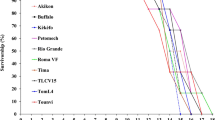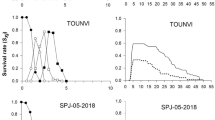Abstract
The spider mite Tetranychus evansi has a broad range of host plants. Control of T. evansi has been a big challenge to tomato farmers due to its fast rate of reproduction, development of resistance to chemical pesticides and its ability to use weeds as alternative hosts when the tomato plants are not available. The aim of the current study was to determine the host plant acceptance and the relative contributions of trichomes in the control of the red spider mite by comparing the survival, development and oviposition rates of the red spider mite on eight tomato accessions. Leaflets from eight tomato varieties were assayed with the spider mites to determine the egg laying capacity and developmental time of the spider mites on the tomato accessions as well as the trichome densities. Densities of trichome types I, IV, V and VI varied among the tomato accessions. Variation in types I, IV and VI accounted for most of the variation in mite responses. The varieties with high densities of types IV and VI had the highest fecundity and mite development did not go beyond the larval stage. The developmental time varied significantly among the tomato accessions. The results indicated that the higher the density of trichome type I the lower the adult survival. The findings indicated possible resistance of some of the tested tomato accessions against T. evansi which is partially associated with trichomes types and density.


Similar content being viewed by others
References
Freitas JA, Maluf WR, Cardoso MG, Gomes LAA, Bearzotti E (2002) Inheritance of foliar zingiberene contents and their relationship to trichome densities and whitefly resistance in tomatoes. Euphytica 127:275–287
Goffreda JC, Mutschler MA, Ave DA, Tingey WM, Steffens JC (1989) Aphid deterrence by glucose esters in glandular trichome exudates of the wild tomato Lycopersicon pennellii. Chem Ecol 15:2135–2147
Good DE, Snyder CJ (1988) Seasonal variation of leaves and mite resistance of Lycopersicon interspesific hybdrids. Hortscience 23:891–894
Knapp M, Luchen SWS (2000) Tetranynchus evansi a new challenge to small-holder tomato growers in southern Africa. Abstracts, XXI International congress of entomology, Foz do Iguassu, Brazil, pp 12–13
Maluf WR, Barbosa LV, Costa SLV (1997) 2-Tridecanone mediated mechanisms of resistance to the South American tomato pinworm Scrobipalpuloides absoluta (Meryrick, 1917) (Lepidoptera-Chelechiidae) in Lycopersicon spp. Euphytica 93:189–194
Maluf WR, Campos AG, Cardoso GM (2001) Relations between trichome types and spider mite (Tetranychus evansi) repellence in tomatoes with respect to foliar Zingiberene contents. Euphytica 121:73–80
Muigai SG, Schuster DJ, Snyder JC, Scott JW, Bassett MJ, McAuslane HJ (2002) Mechanisms of resistance in Lycopersicon germplasm to the whitefly Bemisia argentifolii. Phytoparasitica 30:3347–3360
Qureshi HA, Oatman RE, Fleschner CA (1969) Biology of spider mite, Teranychus evansi. Ann Entomol Soc Am 62:898–903
Sibanda T, Dobson HM, Cooper JF, Manyangarirwa W, Chiimba W (2000) Pest management challenges for smallholder vegetable farmers in Zimbabwe. Crop protection 19: 807–815
Silva et al (1992) In: Gonçalves MIF, Maluf WR, Gomes LAA, Barbosa LV (1998) Varriation of 2-tridecanone level in tomato plant leaflets and resistance to two mite species (Tetranychus spp.). Euphytica 104:33–38
Simmons AT, Gurr GM (2005) Trichomes of Lycopersicon spp. and their hybrids: effects on pests and natural enemies. Agri Entomol 7:265–276
Simmons AT, Gurr GM, McGrath D, Nicol HI, Martin PM (2003) Trichomes of Lycopersicon spp and their effect on Myzus pericae (Sulzer) (Hemiptera: Aphidae). Aust J Entomol 42:373–378
Simmons AT, Gurr GM, McGrath D, Nicol HI, Martin PM (2004) Entrapment of Helicoverpa armigera (Hübner) (Lepidoptera: Noctuidae) on glandular trichomes of Lycopersicon species. Aust J Entomol 43:196–200
Snyder CJ, Carter DC (1984) Leaf trichomes and resistance of Lycopersicon hirsutum and Lycopersicon esculentum to spider mites. J Am Soc Hort Sci 109:337–843
Stoner AK, Frank JA, Gentile AG (1968) In: Snyder CJ, Carter DC (1984) Leaf trichomes and resistance of Lycopersicon hirsutum and Lycopersicon esculentum to spider mites. J Am Soc Hort Sci 109:337–843
Acknowledgments
We are grateful to the International centre for insect physiology and ecology (ICIPE) Kenya (Duduville) for funding this project.
Author information
Authors and Affiliations
Corresponding author
Rights and permissions
About this article
Cite this article
Onyambus, G.K., Maranga, R.O., Gitonga, L.M. et al. Host plant resistance among tomato accessions to the spider mite Tetranychus evansi in Kenya. Exp Appl Acarol 54, 385–393 (2011). https://doi.org/10.1007/s10493-011-9446-4
Received:
Accepted:
Published:
Issue Date:
DOI: https://doi.org/10.1007/s10493-011-9446-4




